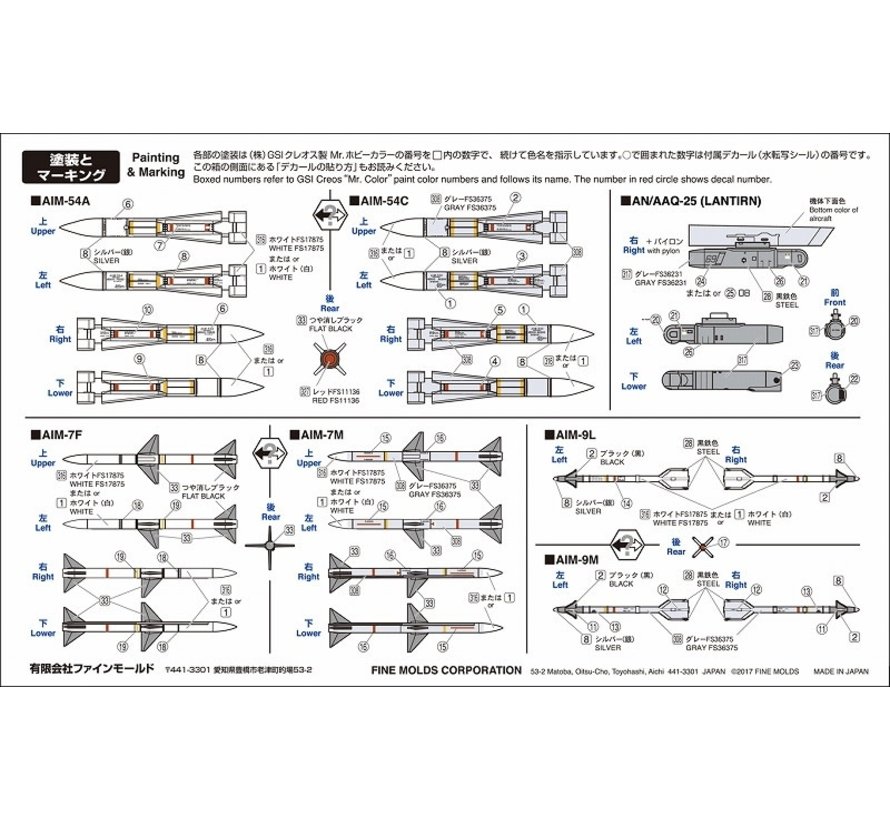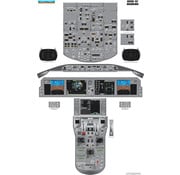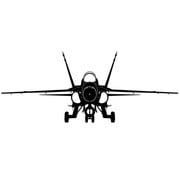US Air-to-Air missile set 1:72
The AIM-54 Phoenix was an American long-range air-to-air missile from the Cold War period. Its first prototypes appeared in the early 1960s, and it was used by the US armed forces in the years 1974-2004. The AIM-54 Phoenix was a solid fuel-powered missile with a range of up to 183 kilometers, capable of carrying a warhead weighing 60 kg with a total curb weight of 462 kg.
The AIM-54 Phoenix missile was originally developed as the main weapon of the F-111 in the fighter version (F-111B). However, when the US Navy withdrew from this idea and decided to develop a completely new aircraft, which later became the F-14 Tomcat, the AIM-54 missile also changed its target host. The missile was developed by the Hughes and Raytheon companies, and its main task was to destroy enemy aircraft at very long distances. The first mass-produced version was the AIM-54A, later a modernized version (AIM-54B) with greater anti-cruise missile capabilities was introduced. In 1986, the AIM-54C version entered the line, which had significantly modernized guidance systems and was less susceptible to interference. It also had a greater range than the previous versions. The only aircraft in the US Navy to carry AIM-54 missiles was the F-14 Tomcat. In turn, the only foreign user of these missiles was Iran, which, moreover, purchased them together with the F-14 aircraft.
The AIM-7 Sparrow is a modern American medium-range air-to-air missile. Its first prototypes appeared in the early 1950s, and it entered the US armed forces in 1956, and it still remains there. The AIM-7 Sparrow is a solid fuel-powered missile with a range of up to 70 kilometers, capable of carrying a warhead weighing 40 kg with a total curb weight of 213 kg.
The AIM-7 Sparrow missile was developed by Raytheon and features - modern versions - a semi-active guidance system. The genesis of this type of missile dates back to the mid-1940s, when work on guided air-to-air missiles began on the order of the US Navy. From 1956, successive versions of the Sparrow rocket, designated Sparrow I, II and III, were introduced into equipment, however, they had many "childhood diseases", especially problems with guidance in the earliest versions. In 1963, however, the modernized AIM-7E missile was introduced into service, but it was inferior to the AIM-9 Sidewinder missiles produced in parallel. The AIM-7F Sparrow missile turned out to be a big change in terms of quality, with an effective range of up to 45 kilometers, an effective and reliable guidance system, and a significantly improved propulsion. In the 1980s, another version of the missile was introduced: the AIM-7M, which had a modernized guidance system that was much less susceptible to interference. It is estimated that over 70,000 copies of the Sparrow missile have been produced during the long history of the Sparrow missile. In the US armed forces, it was or is carried by such aircraft as: F-4 Phantom II, F-15 Eagle, F-16 C / D Fighting Falcon or F-14 Tomcat. The users of the AIM-7 Sparrow missiles were or are also many other countries, for example: Australia, Egypt, Greece, Jordan, Kuwait, Turkey and the United Kingdom.
The AIM-9 Sidewinder is a modern American short-range air-to-air missile. Its first prototypes appeared in the early 1950s, and it entered the US armed forces in 1955/1956, remaining there today. The AIM-9 Sidewinder is a missile with a range of up to 35 kilometers, capable of carrying a warhead weighing 9.4 kg with a total curb weight of 91 kilograms.
The AIM-9 Sidewinder proved to be the first effective and combatable air-to-air missile in the history of the US military. Raytheon was primarily responsible for its development, but also Philco and General Electric. Many variants of this missile were created in the course of serial production. One of the most important was the AIM-9L, which was put into service in 1977. It could track the enemy plane no matter what direction it was launched towards it (from the side, from below, etc.). It also had much better guidance systems than the previous versions. The latest version is the AIM-9X, which was first tested in 1999. AIM-9X can be used in all weather conditions, day and night, it can also be launched without prior "lighting" the target. It is characterized by a very high degree of maneuverability and high resistance to jamming. In the US armed forces, AIM-9 missiles of various versions were or are carried by such aircraft and helicopters as, for example: F-4 Phantom, F-15 Eagle, F-16 C / D Fighting Falcon or AH-64 Apache. The users of the AIM-9 Sidewinder missiles were or are also many other countries, for example: Australia, Belgium, Egypt, Greece, Israel, Kuwait, Turkey and the United Kingdom. Missiles of this type were used in combat, among others during the Vietnam War (1964 / 1965-1975), the Falklands War in 1982 and during the Operation Desert Storm (1990-1991).







